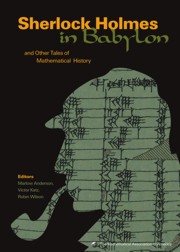Book contents
- Frontmatter
- Introduction
- Contents
- Ancient Mathematics
- Foreword
- Sherlock Holmes in Babylon
- Words and Pictures: New Light on Plimpton 322
- Mathematics, 600 B.C.–600 A.D.
- Diophantus of Alexandria
- Hypatia of Alexandria
- Hypatia and Her Mathematics
- The Evolution of Mathematics in Ancient China
- Liu Hui and the First Golden Age of Chinese Mathematics
- Number Systems of the North American Indians
- The Number System of the Mayas
- Before The Conquest
- Afterword
- Medieval and Renaissance Mathematics
- The Seventeenth Century
- The Eighteenth Century
- Index
- About the Editors
Liu Hui and the First Golden Age of Chinese Mathematics
from Ancient Mathematics
- Frontmatter
- Introduction
- Contents
- Ancient Mathematics
- Foreword
- Sherlock Holmes in Babylon
- Words and Pictures: New Light on Plimpton 322
- Mathematics, 600 B.C.–600 A.D.
- Diophantus of Alexandria
- Hypatia of Alexandria
- Hypatia and Her Mathematics
- The Evolution of Mathematics in Ancient China
- Liu Hui and the First Golden Age of Chinese Mathematics
- Number Systems of the North American Indians
- The Number System of the Mayas
- Before The Conquest
- Afterword
- Medieval and Renaissance Mathematics
- The Seventeenth Century
- The Eighteenth Century
- Index
- About the Editors
Summary
Introduction
Very little is known of the life of Liu Hui, except that he lived in the Kingdom of Wei in the third century A.D., when China was divided into three kingdoms at continual war with one another. What is known is that Liu was a mathematician of great power and creativity. Liu's ideas are preserved in two works which survived and became classics in Chinese mathematics. The most important of these is his commentary, dated 263 A.D., on the Jiuzhang suanshu, the great problem book known in the West as the Nine Chapters on the Mathematical Art. The second is an independent work on mathematics for surveying, the Haidao suanjing, known as the Sea Island Mathematical Manual.
In this paper I would like to tell you about some of the remarkable results and methods in these two works. I think they should be more widely known, for several reasons. First, we and our students should know more about mathematics in other cultures, and we are probably less familiar with Chinese mathematics than with the Greek, Indian and Islamic traditions more directly linked to the historical development of modern mathematics. Second, Western mathematicians who do know something about the Chinese tradition often characterize Chinese mathematics as calculational and utilitarian rather than theoretical. Chinese mathematicians, it is said, developed clever methods, but did not care about mathematical justification of those methods.
- Type
- Chapter
- Information
- Sherlock Holmes in BabylonAnd Other Tales of Mathematical History, pp. 69 - 82Publisher: Mathematical Association of AmericaPrint publication year: 2003



